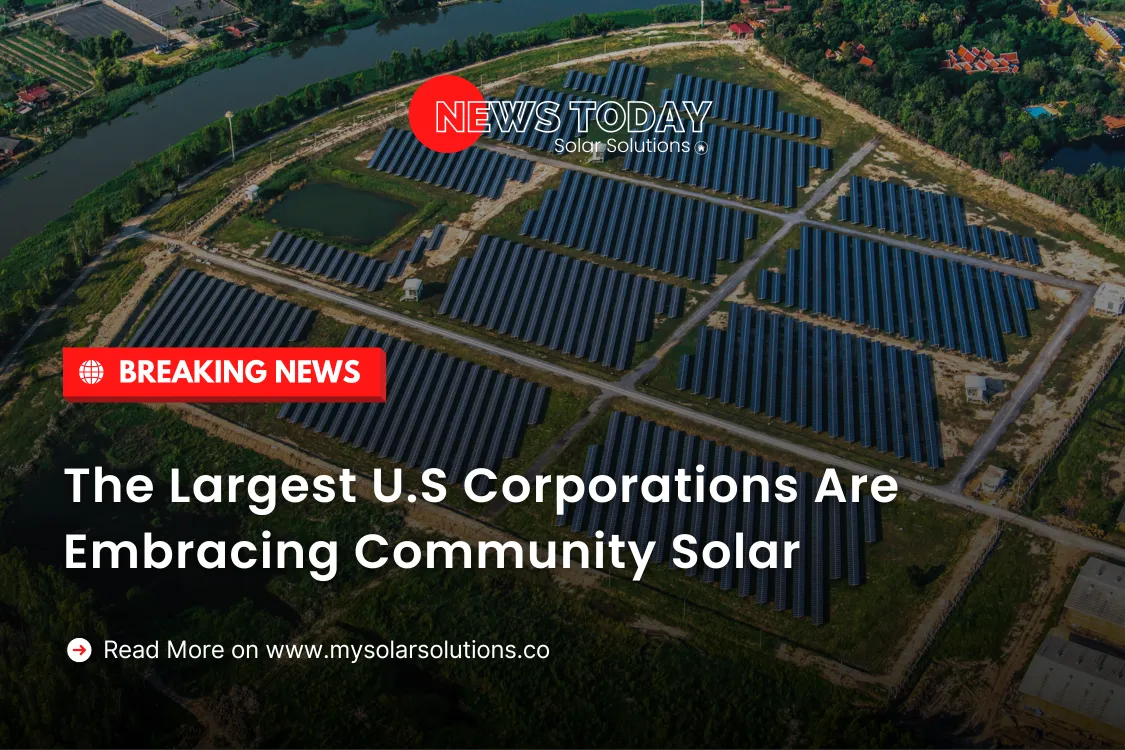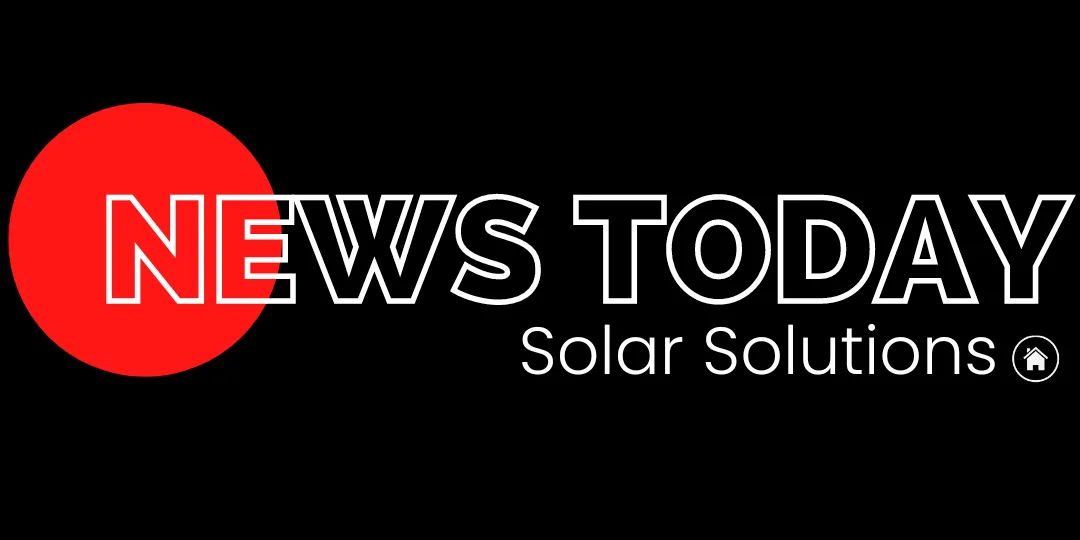The Solar Industries Trusted News Source
Solar News Today
Transparent Reporting for a Sustainable Future
Latest News Stories

The Largest U.S Corporations Are Embracing Community Solar
Community solar is gaining momentum across the United States, with numerous Fortune 500 companies tapping into its potential to meet sustainability goals, provide cost savings, and revitalize communities. Let’s dive into what community solar is, why it’s important, and how major players like Microsoft, Walmart, and Starbucks are using it to shape a more sustainable future.
What is Community Solar?
Community solar projects allow numerous subscribers to benefit from a single solar installation, typically located off-site. Essentially, it's a way for individuals and businesses to share the benefits of solar energy without the need for individual solar panels on-site.
Key Components of Community Solar
Shared Ownership: Multiple customers subscribe to a portion of a solar project's generating capacity.
Utility Bill Credits: Subscribers receive credits on their utility bills based on the electricity produced by the project.
Accessibility: Particularly beneficial for renters or those unable to install solar panels on their property.
The Growing Trend of Community Solar in the U.S.
According to the Coalition for Community Solar Access (CCSA), the installed capacity of community solar in the U.S. has surpassed 7 GW, and this figure is expected to double in the next five years. But what’s driving this growth?
Why Corporations Are Joining the Community Solar Movement
Major corporations are increasingly signing agreements with community solar developers for several compelling reasons:
Meeting Clean Energy Goals: Many companies set ambitious targets to source their energy from renewable sources.
Faster Project Implementation: Community solar projects often come online much quicker than traditional utility-scale solar projects.
Support for Environmental Justice: Many projects focus on providing lower-cost energy to low-income families, aligning with corporate social responsibility goals.
Notable Corporate Partnerships in Community Solar
Let’s take a closer look at some key partnerships that illustrate the trend of corporations embracing community solar.
Microsoft’s Commitment to Community Solar
Microsoft has made significant strides in community solar investment:
Partnership with Pivot Energy: This five-year partnership aims to develop up to 500 MW of community-scale solar projects, generating over 1 billion kWh annually starting in 2025.
Sustainability Goals: Microsoft aims to meet 100% of its data center energy needs with renewable energy by 2025 and achieve carbon negativity by 2030.
“An economy fueled by clean, distributed energy can do more than provide power at low cost; it drives growth and success in communities across the nation.” — Adrian Anderson, Microsoft
Walmart’s Expanding Solar Portfolio
Walmart is also heavily investing in community solar:
Investment in 19 Solar Projects: Walmart's recent partnership with Pivot Energy encompasses 19 projects, with 15 being community solar.
Job Creation and Savings: These projects will provide 72 MW of community solar and are expected to save participants around $6 million annually.
Wendy’s Solar Initiative
Wendy's is taking steps to reduce its carbon footprint through community solar efforts:
Sourcing Solar Energy: Wendy's will source 30% to 100% of its energy from solar through partnerships with companies like Ampion.
Reduction Targets: The company aims to cut its emissions by 47% by 2030.
Starbucks and Rivian: Innovative Collaborations
Starbucks and Rivian are also leveraging community solar:
Starbucks’ 40 MW Agreement: Starbucks’ partnership with Nexamp engages 40 MW of community solar in Illinois, allowing the company to contribute to local renewable energy production.
Rivian’s Community Contributions: Every MW purchased includes a $5,000 donation to local community development, further enhancing the benefits of community solar.
Why Community Solar Makes Sense for Corporations
Many companies are discovering that community solar offers them more than just a way to meet energy goals. It's also about giving back and fostering community development.
Benefits of Community Solar for Businesses
Cost Savings: Non-profit and for-profit entities benefit from reduced energy bills.
Enhanced Brand Image: Companies position themselves as environmentally conscious leaders.
Community Development: Investments in community solar can drive local economic growth and create jobs.
The Future of Community Solar in the U.S.
With current supportive policies in 19 states and the District of Columbia, community solar is set to become a cornerstone of the renewable energy landscape.
Legislative Support for Community Solar
Community solar’s legal landscape is evolving:
State Legislation: Multiple states are advancing legislation to enable new community solar programs.
Federal Interest: The Department of Energy is also engaging with community solar initiatives, demonstrating a broader commitment to renewable energy.
In a world where sustainability is becoming a driving force, community solar presents a unique opportunity for corporations to harness the power of the sun while giving back to their communities. The commitment from major businesses like Microsoft, Walmart, and Starbucks signals a bright future for community solar, benefiting not just companies but also the communities they serve.
By engaging in community solar projects, these corporations are not merely pursuing profit; they are fostering sustainable development and helping pave the way toward a greener, cleaner future. As more companies join this movement, we can expect to see innovations, increased accessibility, and significant strides toward renewable energy goals.
Frequently Asked Questions (FAQs)
1. What is community solar?
Community solar allows multiple subscribers to share the benefits of a single off-site solar installation, receiving utility bill credits based on their subscription. This model enables those who cannot install solar panels to access renewable energy.
2. How do companies benefit from community solar?
Companies benefit from community solar by achieving sustainability targets, reducing energy costs, and enhancing their brand image through corporate social responsibility initiatives.
3. Why is community solar important for low-income communities?
Community solar projects often prioritize low- and moderate-income households, delivering lower-cost energy options and promoting energy equity in underserved areas.
4. What states support community solar initiatives?
Currently, 19 states and the District of Columbia have policies in place to support community solar projects, with more states considering similar legislation.
5. How can individuals participate in community solar?
Individuals can participate by subscribing to a community solar project, which allows them to receive credits on their utility bills based on their share of the solar energy produced.
MEET THE FOUNDER & CEO
Hey, I'm Kiara!
I bring over a decade of experience in the solar industry, combined with a background in Journalism, to inform and empower others.
As the founder of the largest virtual solar brokerage in America, my mission is to provide transparency and clarity to the world of renewable energy.
Welcome to the news page of My Solar Solutions, your premier source for comprehensive solar news in the United States. We are dedicated to delivering the latest insights, updates, and innovations from the solar energy sector. As the nation's go-to platform for solar information, we cover everything from cutting-edge technologies to policy changes and market trends, ensuring that our audience stays informed and empowered to make decisions about renewable energy
Why Solar News Matters
The solar industry is a dynamic and rapidly evolving field. From breakthroughs in photovoltaic technology to shifts in government incentives, staying updated is essential for homeowners, businesses, and industry professionals alike. Solar energy is at the forefront of the global transition to sustainable power, making it a key player in addressing climate change and reducing reliance on fossil fuels. At My Solar Solutions, we recognize the critical role that information plays in shaping this transition. By providing reliable, accurate, and timely news, we aim to be the trusted source for anyone seeking to understand or engage with the solar industry. Whether you're a homeowner considering solar panels, a business exploring energy-saving solutions, or an enthusiast keen on the latest trends, our news page has something for you.

What We Cover...

Technological Innovations
Solar technology is advancing at an unprecedented pace. Our news page features updates on groundbreaking developments, including:
High-efficiency panels: Learn about the latest solar panels, including advancements in materials like perovskite and bifacial designs.
Energy storage: Discover innovations in battery technologies that enhance the reliability and scalability of solar systems.
Smart grids: Stay informed about how solar integrates with smart grid systems to optimize energy distribution.

Market Trends and Analysis
Understanding market dynamics is crucial for anyone involved in solar energy. Our articles delve into:
Solar adoption rates: Explore data on how solar installations are growing across residential, commercial, and industrial sectors.
Pricing trends: Get insights into the costs of solar panels, inverters, batteries, and installation services.
Investment opportunities: Stay ahead with information about renewable energy stocks, tax credits, and financial incentives.

Policy and Legislation
Solar energy thrives on supportive policies. Our coverage includes:
Federal and state incentives: Learn about tax credits, rebates, and grants available to solar adopters.
Regulations: Understand net metering policies, permitting processes, and compliance requirements.
Global policies: Discover how international agreements and policies impact the U.S. solar industry.

Environmental Impact
Solar energy plays a pivotal role in reducing greenhouse gas emissions and combating climate change. Our content highlights
Carbon savings: Quantify the environmental benefits of switching to solar energy.
Sustainability practices: Explore how solar aligns with broader environmental and sustainability goals.
Case studies: Read about successful projects that showcase the positive impact of solar energy on communities and ecosystems.

Solar Success Stories
Real-world applications of solar energy inspire and inform. We feature:
Residential installations: See how homeowners are transforming their energy usage with solar panels.
Business case studies: Learn about companies leading the charge in renewable energy adoption.
Community projects: Discover how solar energy is empowering underserved regions and creating jobs.

Challenges and Solutions
While solar energy offers numerous benefits, challenges remain. We address issues like:
Grid reliability: Explore how solar interacts with aging grid infrastructure.
Material sourcing: Understand the sustainability concerns related to raw materials for solar panels and batteries.
End-of-life management: Learn about recycling and disposal solutions for solar equipment.
Why Choose My Solar Solutions for Your Solar News?
We take pride in delivering:
Expertise: With over a decade of experience in the solar industry, we bring unparalleled knowledge to our reporting.
Accuracy: Our content is meticulously researched and verified to ensure reliability.
Relevance: We focus on topics that matter most to our audience, from homeowners to industry professionals.
Our commitment to quality has earned us a reputation as the authoritative source for solar news in the U.S. By choosing My Solar Solutions, you are choosing a partner dedicated to your energy independence and environmental stewardship
Our Vision For The Future
At My Solar Solutions, our vision extends beyond providing news. We aim to:
Advocate for policy changes: Support initiatives that make solar energy more accessible and affordable.
Drive innovation: Partner with industry leaders to bring the latest technologies to market.
Promote sustainability: Champion practices that prioritize environmental health and resource conservation.
By aligning with these goals, we strive to create a platform that not only informs but also inspires action.


Facebook
Instagram
X
Youtube